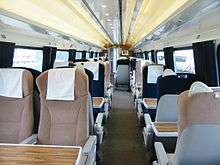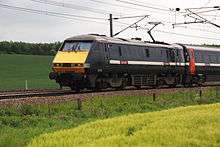InterCity 225
|
An InterCity 225 at speed on the East Coast Main Line | |||||||||||
| |||||||||||
| |||||||||||
| |||||||||||
| |||||||||||

The InterCity 225 is an electric high speed train in the United Kingdom, comprising a Class 91 electric locomotive, nine Mark 4 coaches and a Driving Van Trailer. The Class 91 locomotives were built by BREL at Crewe works as a spin-off from the Advanced Passenger Train project, which was abandoned during the 1980s, whilst the coaches and DVT were constructed by Metro-Cammell in Birmingham and Breda (under sub-contract) in Italy — again borrowing heavily from the Advanced Passenger Train. The trains were designed to operate at up to 140 mph (225 km/h) in regular service, but are limited to 125 mph (200 km/h) principally due to a lack of cab signalling and the limitations of the current overhead line equipment (OLE). They are used on services from London King's Cross to Leeds, Edinburgh Waverley, Glasgow Central, Skipton, Bradford Forster Square, Newark North Gate, York and Newcastle.
Service history
The InterCity 225 entered service with British Rail on the East Coast Main Line in 1990. The units also operate on a small section of the West Coast Main Line between Glasgow and Carstairs. In 1996, as part of the privatisation of British Rail, all InterCity 225s were sold to Eversholt Rail Group, which currently leases them to Virgin Trains East Coast.
The InterCity 225 has a top service speed of 140 mph (225 km/h); during a test run on Stoke Bank between Peterborough and Grantham an Intercity 225 reached 161.7 mph (260.2 km/h). However, except on High Speed 1, which is equipped with cab signalling, British signalling does not allow trains to exceed 125 mph (201 km/h) in regular service, due to the impracticality of correctly observing lineside signals at high speed.
Between 2001 and April 2006, HSBC Rail (IC225 owner, now Eversholt Rail Group) initiated and funded with support from GNER and Bombardier Transportation and Alstom and others a complete rebuilding and refurbishment programme for both the Class 91 and Mark 4 coaches, called Project Mallard.
Capacity and Formation
The formation of the InterCity 225 sets is below:- [3]
- Class 91 Electric Locomotive (North End)
- Coach B - Standard Class - 76 Seats - WC
- Coach C - Standard Class - 76 Seats - WC
- Coach D - Standard Class - 76 Seats - WC
- Coach E - Standard Class - 76 Seats - WC
- Coach F - Standard Class - 72 Seats - Accessible Toilet
- Coach H - Standard Class/Kitchen - 30 Seats - WC
- Coach K - First Class - 43 Seats - WC + 2 Crew Areas
- Coach L - First Class - 40 Seats - Accessible Toilet
- Coach M - First Class - 46 Seats - WC
- Driving Van Trailer (London End)
Total number of seats is 406 Standard and 129 First which when joined together, give the train a total capacity of 535 seats.
Replacements
The finalised £4.5 billion contract for the Intercity Express Programme trains for the Great Western Main Line and East Coast Main Line (ECML) was announced in July 2012.[4] Capital costs for the vehicles are approximately £2.8 million per carriage for bi-mode versions and £2.4 million per carriage for electric versions.[5] Financial closure was reached on the first phase of the contract, valued at £2.4bn, consisting of 21 nine-car electric (Class 801[6]) and 36 five-car bi-mode trains (Class 800[6]), 369 carriages total, for use on Great Western routes.
The second phase of the contract consisted of 10 five-car and 13 nine-car bi-mode and 12 five-car electric units (227 carriages) for use on the ECML;[4] financial closure on the second phase was expected in 2013.[7][8] A £1.2bn option for further 30 nine-car electric trains (270 carriages) to replace Intercity 225 sets on the ECML was taken up on 18 July 2013.[6]
The trains will enter service in 2017 on the Great Western Main Line and 2018 on the East Coast Main Line.[8]
Gallery
- The interior of a refurbished GNER Mark IV TSOE vehicle, showing the small area at the rear of the carriage dedicated for the use of smoking passengers
- The interior of a refurbished GNER Mark IV TSO vehicle
 A GNER liveried Mark IV RSM vehicle
A GNER liveried Mark IV RSM vehicle- The interior of a refurbished GNER Mark IV RSM vehicle, showing the new Standard Class saloon
- The interior of a refurbished GNER Mark IV RSM vehicle, showing the Cafe-Bar buffet counter
 An InterCity 225 at speed on the East Coast Main Line in Nottinghamshire
An InterCity 225 at speed on the East Coast Main Line in Nottinghamshire
See also
- List of high speed trains
- Great North Eastern Railway
- National Express East Coast
- East Coast
- East Coast Main Line
- Class 91 electric locomotive
- Mark 4 coaches
- Driving Van Trailer
- InterCity (British Rail)
- InterCity 125
- InterCity 250
References
- ↑ thejunction.org.uk, rolling stock: class 91, Retrieved on 04-07-2007
- ↑ Oliver Keating, The Inter-city 225, Retrieved on 04-07-2007
- ↑ http://static.eastcoastcdn.co.uk/cdn-1cc20728db77bf5/documents/pdfs/seat%20maps/mallard%20coach2011.pdf
- 1 2 "Agility Trains signs Intercity Express Programme contract". Railway Gazette International. London. 25 July 2012.
- ↑ Sources:
- Johnson, Marc (26 July 2012). "IEPs better value for money than Pendolinos, says DfT". www.rail.co.
- Barrow, Keith (25 July 2012). "Britain's Intercity Express Programme reaches financial close". International Railway Journal.
- 1 2 3 "East Coast Main Line IEP train order confirmed". Railway Gazette International. London. 18 July 2013.
- ↑ Odell, Mark; Pickard, Jim (25 July 2012). "Hitachi secures largest UK train order". Financial Times. London.
- 1 2 "£4.5 billion investment in new trains creates new jobs" (Press release). Department for Transport. 25 July 2012. Retrieved 25 July 2012.
Further reading
- Perren, Brian (October 1988). "Class 91 + Mk 4s = IC225". RAIL. No. 85. EMAP National Publications. pp. 28–34. ISSN 0953-4563. OCLC 49953699.
External links
| Wikimedia Commons has media related to British Rail Class 91. |
| Wikimedia Commons has media related to British Rail Mk4 coaches. |
| Wikimedia Commons has media related to British Rail Mk4 DVT. |
.jpg)